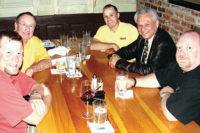For the past two years, computerized maintenance management systems (CMMS) from software provider Eagle Technology, Inc. (Mequon, WI) have helped the maintenance staff of Bartle Hall keep the facility in top condition for the millions of visitors who attend events there every year. With 388,000 sq ft of continuous, column-free space, Bartle's main exhibit area is approximately the size of eight football fields and can accommodate 2,000 10- by 10-ft booths.
Sound-resistant movable walls can divide the main area into five separate exhibit areas, while the center's design, featuring multiple telephone banks, show offices, restrooms, and concession stands of the facility's perimeter ensures that simultaneous events can all offer full guest services. Utility ports, including hookups for electrical, phone, water, compressed air, and natural gas are located on 30-ft centers.
Twenty-nine truck bays and two 10,000-lb service elevators serve the facility, and a live load limit of 300 lb/psi means that 18-wheel semis can drive right onto the exhibit floor for setup. The two meeting areas offer 68,000 sq ft of space in 29 rooms, the largest of which is capable of accommodating 7,000 people in theatre-style seating or 1,500 banquet style. Bartle Hall is adjacent to Barney Allis Plaza, a park concealing 1,000 underground parking spaces. The plaza also provides access to an underground walkway system that connects Bartle Hall and the surrounding facilities with nearby hotels.
Lengthy Selection Process
In 1998, Bartle Hall's maintenance manager, Dean Barrett, was asked to select a CMMS to help with maintenance planning and tracking for the facility. He began his search by looking at demo programs from 15 different software companies. Of these 15, five were invited to give presentations at Bartle. Barrett evaluated the systems based on how they would work in achieving the goals the center had set for CMMS usage. "We were looking for a user-friendly program," he remembers, "with the ability to interface with building automation systems (bas) and one that would be flexible enough to customize to our needs."Research showed that Eagle's Maintenance Manager software was the best fit and the program was selected and installed in 2000. Maintenance Manager also offers an interface to Johnson Controls' Metasys(r) bas and can generate workorders automatically whenever a piece of Metasys-tracked facility equipment goes into an alarm condition. The interface can also be configured to generate work- orders when equipment reaches a predetermined preventive maintenance runtime total.
For flexibility, Maintenance Manager can run in a networked or standalone environment. Also, user-defined fields in all files mean that users can choose the terminology they use in tracking maintenance information. "We also bought the system to help 'justify our existence' (as a maintenance department) so we needed it to generate labor statistics and information on job/class/person/tasks," Barrett adds. After Maintenance Manager was selected, representatives from Eagle made two trips to Bartle Hall to install the software and train the staff.
From AHU's To Toilets
Bartle's maintenance department now uses the CMMS for total facility maintenance. They track everything from air-handling equipment, facility inspection data, and elevator/escalator repairs to flush auditors in all the toilets and basic facility cleanliness. Spare parts inventory is handled through a different department that also uses Maintenance Manager.According to Barrett, a 12,000-item inventory is tracked with the system.
The result of using Maintenance Manager at Bartle Hall? Barrett says, "The program has increased our productivity and allowed us to track work better." One of the useful features Barrett mentions specifically is a maintenance history function that is useful in identifying and eliminating causes of repeat failures. "Maintenance Manager allows us to identify the same problems when they come up again and again so we can take care of them," he says.
Another key feature is the Service Request Module. In large facilities like Bartle Hall, people will often need to request service even though they are not close to a Maintenance Manager workstation. Usually this means the maintenance department is stuck answering calls or sifting through paper memos. With Service Request, computers without Maintenance Manager installed can transmit requests directly into the CMMS. These requests can either be automatically created as workorders or can be routed through an administrator who decides whether to accept the request or not.
Barrett sums up his experiences with the software by saying, "Maintenance Manager is very flexible, with pretty much any capability. If you want to track anything, from purchasing to payroll, you can."ES








